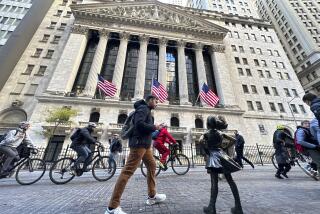Stocks slide as oil market continues to crumble
U.S. stocks sank Tuesday to their biggest loss in weeks as oil prices crumpled and worries swept markets worldwide about the economic carnage caused by the coronavirus pandemic.
The market’s spotlight was again on oil, where prices have plummeted because very few people are flying or driving, and factories have shut amid widespread stay-at-home orders. Global demand is set to drop to levels last seen in the mid-1990s. At the same time, oil producers aren’t slowing their production fast enough, and all the extra crude means storage tanks are quickly filling up.
Oil tankers carrying enough crude to satisfy 20% of the world’s consumption are gathered off California’s coast with nowhere to go.
The price for a barrel of U.S. oil to be delivered in June plunged 43% to $11.57. That’s the part of the market that oil traders are focused on and trading most actively. For oil to be delivered next month, which is when storage tanks could top out, the cost of a barrel stood at $10.01. A day earlier, it fell below zero for the first time, meaning traders paid others to take oil off their hands to get rid of the headache of finding places to store it.
Analysts consider prices for U.S. oil to be delivered in June and later as closer to the “true“ price of crude, along with prices for international oils. They did not drop below zero, in part because the storage issues aren’t as pressing for them. But they also slid Tuesday on the same concern: A global economy incapacitated by the virus outbreak doesn’t need to burn as much fuel.
Brent crude, the international standard, for delivery in June lost 24.4% to $19.33 a barrel.
“I don’t think there’s enough time even before the June contract to solve the storage capacity issue, so you see the June contract coming down sharply,” said David Joy, chief market strategist at Ameriprise Financial.
The crumbling oil market helped drag stocks to their second straight day of losses, with the Standard & Poor’s 500 index declining 3.1%, its biggest drop since April 1, after markets across Europe and Asia posted similar drops.
The S&P 500 fell 86.60 points to 2,736.56. The losses were widespread, with 94% of stocks in the index down. Even shares of some recent winners in the new stuck-at-home economy dropped. Netflix slipped 0.8%; trading closed before it announced its quarterly results, including a 23% rise in global memberships.
The Dow Jones industrial average fell 631.56 points, or 2.7%, to 23,018.88. The Nasdaq slid 297.50 points, or 3.5%, to 8,263.23.
“The markets have largely escaped panic mode but are not out of the volatility yet,” said Brian Nick, chief investment strategist for Nuveen.
In another sign of the concern washing over markets, Treasury yields fell further. The yield on the 10-year Treasury dropped to 0.56% from 0.62%, meaning investors are willing to accept lower payment because they more deeply want the safety of owning a U.S. government bond.
Meanwhile, signs of economic activity on the horizon were poking through. The Senate approved a coronavirus aid bill worth nearly $500 billion that would provide more loans to small businesses and aid to hospitals. Georgia’s governor announced plans late Monday to let gyms, hair salons and other businesses reopen as early as Friday.
Rising optimism among some investors that parts of the economy could reopen as infections level off have helped stocks rally recently, and the S&P 500 is up more than 22% since its low in late March. The rally got its start after the Federal Reserve and Congress promised massive amounts of aid for the economy.
“It looks like we’re bending the infection curve, there are signs of economic reopening, and the stimulus is there,” said Rob Haworth, senior investment strategist at U.S. Bank Wealth Management. “All of which are good signs for the markets, where there’s a potential scenario where the economy starts to recover.”
But the data coming in on the economy continue to be dismal, including a Tuesday report that showed the steepest drop since 2015 for U.S. sales of previously occupied homes. Pessimists say that the market’s rally has been overdone and that a premature reopening of the economy could just invite more flare-ups of infections.
“If you start to see cases go back up in a pronounced way, it’s a sign that we may have trouble escaping this,” Nuveen’s Nick said.
Companies are also describing the hit to earnings they’re taking from the outbreak. Many have pulled their financial forecasts for the year given the uncertainty about how long this recession will last. Coca-Cola said Tuesday that its sales had been on track to hit financial targets through February, but that all changed when stay-at-home orders became widespread in March. It said it’s hopeful that improvement could arrive in the second half of the year. Late Monday, IBM withdrew its guidance for 2020 results and said it will reassess at the end of June.
“There’s still a lot of uncertainty about this market,” said Ameriprise Financial’s Joy, “and it’s understandable because the visibility on earnings and the economy even is very limited still.”
Bloomberg was used in compiling this report.
More to Read
Inside the business of entertainment
The Wide Shot brings you news, analysis and insights on everything from streaming wars to production — and what it all means for the future.
You may occasionally receive promotional content from the Los Angeles Times.






